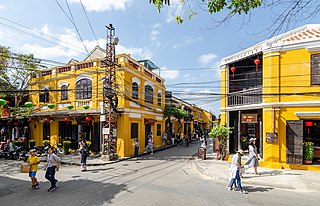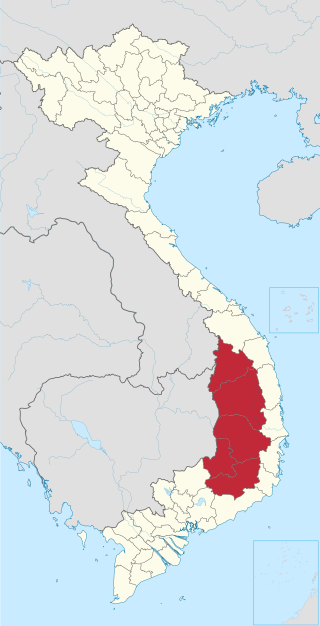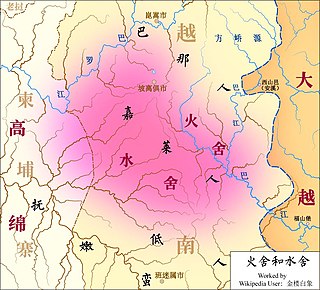Articles related to Vietnam and Vietnamese culture include:

Quảng Nam is a coastal province located in the northernmost coastal region of South Central and Central Vietnam. Quang Nam is located in the key economic region of the Central region. In 1997, the province was re-established on the basis of separating Quang Nam - Da Nang province into two administrative units, Quang Nam province and Da Nang city. Currently, the province has two cities: Tam Ky city and Hoi An city. Quang Nam province is home to the most world cultural heritages in the country with two world cultural heritages recognized by UNESCO: Hoi An ancient town and My Son temple relic area. Hoi An and the Cham Islands are part of UNESCO Biosphere.

Đắk Lắk is a central mountainous province in the Central Highlands region, the Central of Vietnam. It borders Gia Lai to the north, Phú Yên and Khánh Hòa to the east, Lâm Đồng and Đắk Nông to the south, and Mondulkiri of Cambodia to the west.

Kon Tum City is the capital city of Kon Tum Province in Vietnam. It is located inland in the Central Highlands region of Vietnam, near the borders of Laos and Cambodia.

Kon Tum is the northernmost mountainous province in the Central Highlands region, the Central of Vietnam. It borders Quảng Nam to the north, Gia Lai to the south, Quảng Ngãi to the east, Sekong, Attapeu of Laos and Ratanakiri of Cambodia in the west.

The Central Highlands, South Central Highlands, Western Highlands or Midland Highlands is a region located in the south central part of Vietnam. It contains the provinces of Đắk Lắk, Đắk Nông, Gia Lai, Kon Tum, and Lâm Đồng.

Gia Lai is a northern mountainous province in the Central Highlands region, the Central of Vietnam. It borders Kon Tum in the north, Quảng Ngãi in the northeast, Bình Định in the east, Phú Yên in the southeast, Đắk Lắk in the south and Ratanakiri of Cambodia in the west.

In Vietnam, South Central Coast and South Central Region are two terms which can refer to the same region or two regions that do not correspond to each other. South Central Coast consists of the independent municipality of Đà Nẵng and seven other provinces, which means South Central Coast doesn't include Central Highlands. Nevertheless, the term "South Central Region" can also be used to include Central Highlands as it is part of southern part of Central Vietnam.
Jarai is a Malayo-Polynesian language spoken by the Jarai people of Vietnam and Cambodia. The speakers of Jarai number approximately 530,000, not including other possible Jarai communities in countries other than Vietnam and Cambodia such as United States of America. They are the largest of the upland ethnic groups of Vietnam's Central Highlands known as Degar or Montagnards, and 25 per cent of the population in the Cambodian province of Ratanakiri.
The Bahnar language or Ba-Na language is a Central Bahnaric language. It has nine vowel qualities and phonemic vowel length.

The 23rd Division of the Army of the Republic of Vietnam (ARVN)—the army of the nation state of South Vietnam that existed from 1955 to 1975—was part of the II Corps that oversaw the Central Highlands.

The 22nd Division of the Army of the Republic of Vietnam (ARVN) was part of the II Corps that oversaw the region of the Central Highlands north of the capital Saigon. The 22nd Division was based in Ba Gi near the south central coast.

Ba River is a river in the South Central Coast region of Vietnam. It has its source in Kon Tum Province and flows into the South China Sea in Tuy Hòa, Phú Yên Province. It has the largest river valley area in central Vietnam and one of the largest river systems in central Vietnam with a total basin area of 13,900 km² or 4.19% of Vietnam's total area. It has a total length of 374 km.
The Battle of Duc Lap took place during the Vietnam War where North Vietnamese forces attempted to overrun the Civilian Irregular Defense Group (CIDG) Duc Lap Camp between 24 and 27 August 1968.
Rade is an Austronesian language of southern Vietnam. There may be some speakers in Cambodia. It is a member of the Chamic subgroup, and is closely related to the Cham language of central Vietnam.
Tân Hòa may refer to several places in Vietnam, including:

Thủy Xá and Hỏa Xá are Vietnamese names referring to two former Jarai chiefdoms located in Central Highlands of Vietnam. Their leaders used the title "King of Water", "King of Fire" and the lesser-known "King of Wind" respectively. The Jarai word Pơtao were often translated as "king" but were never real kings, actually they were ritual masters of fire, water and wind.
The 968th Infantry Division was a division of the People's Army of Vietnam, first formed in the 1960s.





















